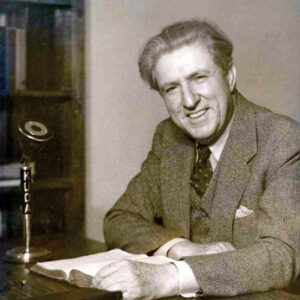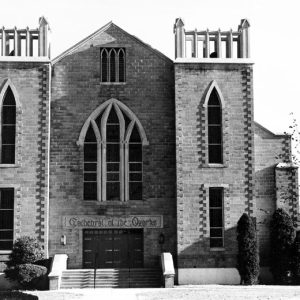calsfoundation@cals.org
John Elward Brown (1879–1957)
A prominent evangelist, publisher, radio pioneer, and educator in the first half of the twentieth century, John Elward Brown established John Brown University (JBU), one of the state’s leading private universities. He was also the leading figure in securing passage of a law prohibiting the sale of alcohol in Benton County, a ban that continued into the twenty-first century.
John Brown was born on April 2, 1879, near Center Point, Iowa, the fifth of nine children born to Civil War veteran John Franklin Brown and his wife, Julia. The elder Brown, weakened by war injuries, could not perform arduous farm work, so the family subsisted on a meager soldier’s pension. At age eleven, Brown dropped out of school to work to supplement the family’s income. At age seventeen, after performing a variety of low-paying menial tasks, Brown accompanied his older brother to Rogers (Benton County) in search of better employment. While in Rogers in 1897, he attended a Salvation Army revival meeting and became a fervent convert to evangelical Christianity.
Soon after, Brown joined the Salvation Army as a staff worker and moved to Siloam Springs (Benton County) to help establish an outpost. In 1899, he left the Salvation Army to become a professional evangelist. For the next few years, as his reputation grew, Brown kept up a hectic pace of preaching at revival meetings, running a publishing house, and reading history and literature late into the night in an attempt to remedy his lack of formal education. By 1910, Brown was one of the leading evangelists in the Southwest. He spent much of his time in the burgeoning Southern California, as well as holding rallies in Texas cities such as Fort Worth and Houston.
In 1900, Brown married Juanita Arrington and bought a farm on the western border of Siloam Springs. They had five daughters and one son.
In 1919, Brown launched another career as an educator. In 1902, he had served a brief tenure as President of Scarritt Collegiate Institute, a fledgling Methodist college in southern Missouri. This experience convinced Brown that American higher education was expensive, impractical, and doing a disservice to young Americans. In August 1919, therefore, Brown converted his 300-acre Siloam Springs farm into the campus of Southwestern Collegiate Institute. The college sought to provide low-cost religious and vocational education for bright, ambitious young people who could not afford college. Eventually the name was changed to John Brown University to capitalize on the founder’s fame as an evangelist.
Brown was a pioneer in the development of radio broadcasting. In 1928, he bought his first radio station, KPFW, and moved it from Cartersville, Missouri, to Siloam Springs. In 1935, in search of a station with higher output, Brown acquired KUOA from the Fulbright Corporation of Fayetteville (Washington County). He moved it to Siloam Springs to serve as the radio voice of John Brown University. KUOA is one of the oldest continually operated radio stations in the country.
Like other religious leaders of his day, Brown occasionally got involved in political causes such as Prohibition. During World War II, he petitioned Benton County for a local option vote, and the county became dry. Liquor merchants engineered a repeal movement in 1947, hoping to capitalize on the votes of soldiers who had returned from the war. But Brown orchestrated a vigorous countywide campaign, and in the end, sixty-one percent of the county’s voters supported Prohibition. By the end of the twentieth century, the ban on liquor sales in Benton County was still in effect.
In his later years, Brown continued to involve himself in national evangelistic campaigns, such as Billy Graham’s Youth for Christ, while overseeing the university. He also developed relationships with prominent politicians and business leaders in the state. In the 1950s, he spent much of his time developing religious and radio enterprises in southern California.
In 1957, Brown fell on the stairs of his San Diego, California, home, breaking his hip. A blood clot developed, and he died on February 12, 1957. He is buried in Siloam Springs.
For additional information:
Kennedy, Ralph, and Charles Rothrock. John Brown of Arkansas. Siloam Springs, AR: John Brown University Press, 1966.
Ostrander, Rick. Head, Heart, and Hand: John Brown University and Modern Evangelical Higher Education. Fayetteville: University of Arkansas Press, 2003.
Rick Ostrander
John Brown University
 John Elward Brown
John Elward Brown  John Elward Brown
John Elward Brown  John Brown University Cathedral
John Brown University Cathedral 




Comments
No comments on this entry yet.